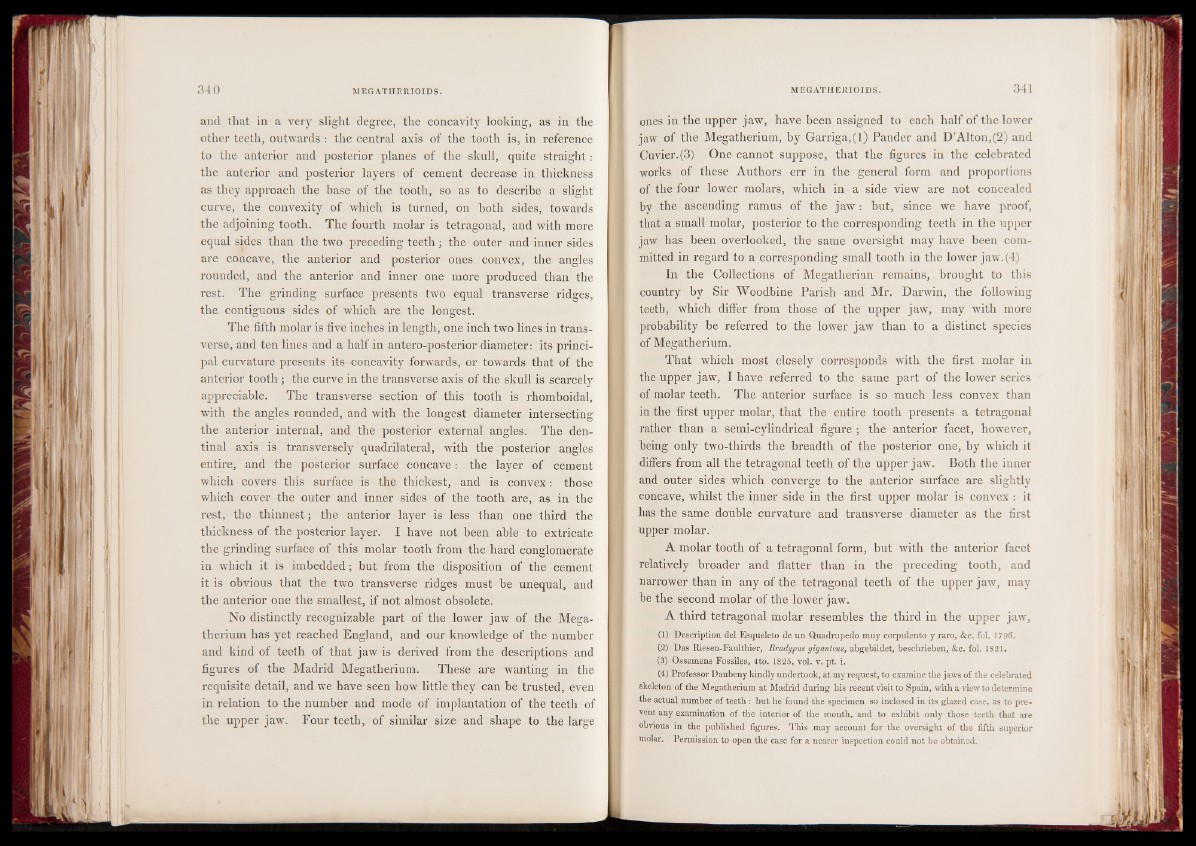
and that in a very slight degree, the concavity looking, as in the
other teeth, outwards : the central axis of the tooth is, in reference
to the anterior and posterior planes of the skull, quite straight :
the anterior and posterior layers of cement decrease in thickness
as they approach thç base of the tooth, so as to describe a slight
curve, the convexity of which is turned, on both sides, towards
the adjoining tooth. The fourth molar is tetragonal, and with more
equal sides than the two preceding teeth ; the outer and inner sides
are concave, the anterior and posterior ones convex, the angles
rounded, and the anterior and inner one more produced than the
rest. The grinding surface presents two equal transverse ridges,
the contiguous sides of which are the longest.
The fifth molar is five inches in length, one inch two lines in transverse,
and ten lines and a half in antero-posterior diameter: its principal
curvature presents its- concavity forwards, or towards that of the
anterior tooth ; the curve in the transverse axis of the skull is scarcely
appreciable. The transverse section of this tooth is rhomboidal,
with the angles rounded, and with the longest diameter intersecting
the anterior internal, and the posterior external angles. The dentinal
axis is transversely quadrilateral, with the posterior angles
entire, and the posterior surface concave : the layer of cement
which covers this surface is the thickest, and is convex : those
which cover the outer and inner sides of the tooth are, as in the
rest, the thinnest ; the anterior layer is less than one third the
thickness of the posterior layer. I have not been able to extricate
the grinding surface of this molar tooth from the hard conglomerate
in which it is imbedded ; hut from the disposition of the cement
it is obvious that the two transverse ridges must be unequal, and
the anterior one the smallest, if not almost obsolete.
No distinctly recognizable part of the lower jaw of the Megatherium
has yet reached England, and our knowledge of the number
and kind of teeth of that jaw is derived from the descriptions and
figures of the Madrid Megatherium. These are wanting in the
requisite detail, and we have seen how little they can be trusted, even
in relation to the number and mode of implantation of the teeth of
the upper jaw. Four teeth, of similar size and shape to the large
ones in the upper jaw, have been assigned to each half of the lower
jaw of the Megatherium, by Garriga,(l) Pander and D’Alton,(2) and
Cuvier. (3) One cannot suppose, that the figures in the celebrated
works of these Authors err in the general form and proportions
of the four lower molars, which in a side view are not concealed
by the ascending ramus of the jaw : but, since we have proof,
that a small molar, posterior to the corresponding teeth in the upper
jaw has been overlooked, the same oversight may have been committed
in regard to a corresponding small tooth in the lower jaw.(4)
In the Collections of Megatherian remains, brought to this
country by Sir Woodbine Parish and Mr. Darwin, the following
teeth, which differ from those of the upper jaw, may with more
probability he referred to the lower jaw than to a distinct species
of Megatherium.
That which most closely corresponds with the first molar in
the upper jaw, I have referred to the same part of the lower series
of molar teeth. The anterior surface is so much less convex than
in the first upper molar, that the entire tooth presents a tetragonal
rather than a semi-cylindrical figure ; the anterior facet, however,
being only two-thirds the breadth of the posterior one, by which it
differs from all the tetragonal teeth of the upper jaw. Both the inner
and outer sides which converge to the anterior surface are slightly
concave, whilst the inner side in the first upper molar is convex : it
has the same double curvature and transverse diameter as the first
upper molar.
A molar tooth of a tetragonal form, but with the anterior facet
relatively broader and flatter than in the preceding tooth, and
narrower than in any of the tetragonal teeth of the upper jaw, may
be the second molar of the lower jaw.
A third tetragonal molar resembles the third in the upper jaw,
(1) Description del Esqueleto de un Quadrupedo muy corpulento y raro, &c. fol. 1796.
(2) Das Riesen-Faulthier, Bradypus giganteus, abgebildet, beschrieben, &e. fol. 1821.
(3) Ossemens Fossiles, 4to. 1825, vol. v. pt. i.
(4) Professor Daubeny kindly undertook, at my request, to examine the jaws of the celebrated
skeleton of the Megatherium at Madrid during his recent visit to Spain, with a view to determine
the actual number of teeth : but he found the specimen so inclosed in its glazed case, as to prevent
any examination of the interior of the mouth, and to exhibit only those teeth that are
obvious in the published figures. This may account for the oversight of the fifth superior
molar. Permission to open the case for a nearer inspection could not be obtained.